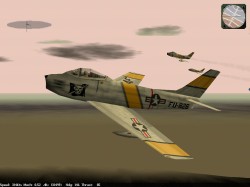|
MiG Alley Beta
by Ron "Baron01" McMasters |
||||
|
I also didn't see much coordination between enemy AI pilots, but that is not necessarily a bad thing; complex air tactics and mutual support were still developing. I did witness some wingman mutual support, but not enough for my blood. The Korean air war was the last of the "gun duels" the world had seen since the advent of the airplane as a weapons platform. With each burst from my guns, I could hear the bullets hitting the MiG. Each hit sounded like breaking glass, but at least I knew I was making contact. If all were canopy hits, then I can understand the sounds, but I wanted more variety (truth be told, you can't hear those sounds from inside the plane). I could have liked to see little pieces coming off the plane. But when the MiG finally exploded, it was pretty impressive. Seeing shards of airplane parts careening through the air toward my windscreen was an awesome sight. But be careful. I got hit with a flipping wing and it ate my lunch, forcing me to eject. Speaking of ejecting, what's the deal with the pancake-looking pilot just hanging there limp, looking like he's dead in the chute? And when he hit the ground (and I mean HIT the ground), my wife was certain I was dead. But I lived to fly and fight another day. I tested ejecting from spins, uncontrolled flight, and at different levels. If I had more than 500 feet, I almost always survived, unless pointed straight down. Most of us know that isn't always the case, especially when the aircraft is in violent, uncontrolled flight. I've witnessed an F-4 Phantom pilot at Clark Air Base, Philippines drill himself into the ground after his controls stuck in the full aft position on takeoff, causing the aircraft to become inverted at about 200 feet. Makes for a bad day at the office. Flight Characteristics OK, now for the good stuff. Many people complain about realism, physics, and flight characteristics. This sim, like all the others, has its ups and downs, but it's mostly positive. Once the small glitches are fixed, this is going to be a hot sim. Needless to say, I fell in love with it. That said, I have some critical remarks along with my praise of the project. |
 On the up side, the flight characteristics are pretty much realistic. The takeoff sequence is pretty good, except the airplane does not leave the ground very smoothly when at rotate speed. The nose wants to porpoise and sink back to the ground. I usually have to jockey the plane up and down to get it flying. I practiced taking off with flaps and that minimized the sinking. But don't raise flaps until you have at least 100 feet of altitude and at least 120 knots of airspeed, or the aircraft will lose lift and it could sink back to the ground, resulting in a crash. The one unrealistic part of the sequence is that the wingmen, who start their takeoff run slightly behind you, actually pass you up while still on the takeoff roll. That would seem improbable when using the same type of aircraft, the same throttle settings, and your aircraft engine spooling up and rolling first. I mean, you are the flight leader, but you will have to chase after your wingmen for a bit. Once airborne, your wingmen will form up in their correct positions. Be careful because every once in a while the wingmen will clip you, resulting in a terrific mid-air or ground collision. More on Flight and Physics How do the aircraft maneuver? You want to jerk your airplane around with wing tanks on? Well, you'll rip them right off. You want to whip and over-G your plane with your ham-fisted flying? You may as well find the "eject" button now because you'll literally tear the plane apart with sustained over-g maneuvers. With force feedback, you can feel every stall buffet, every maneuver, and every shake of the airframe. The wrong maneuver can result in structural damage to the aircraft. The manual didn't provide it, but you had better find out how your plane reacts at different altitudes, speeds, and configurations. GO to Part III: FM and Damage Modeling
|
|||
|
Copyright © 1997 - 2000 COMBATSIM.COM, INC. All Rights Reserved. Last Updated October 1st, 1999 |
||||
